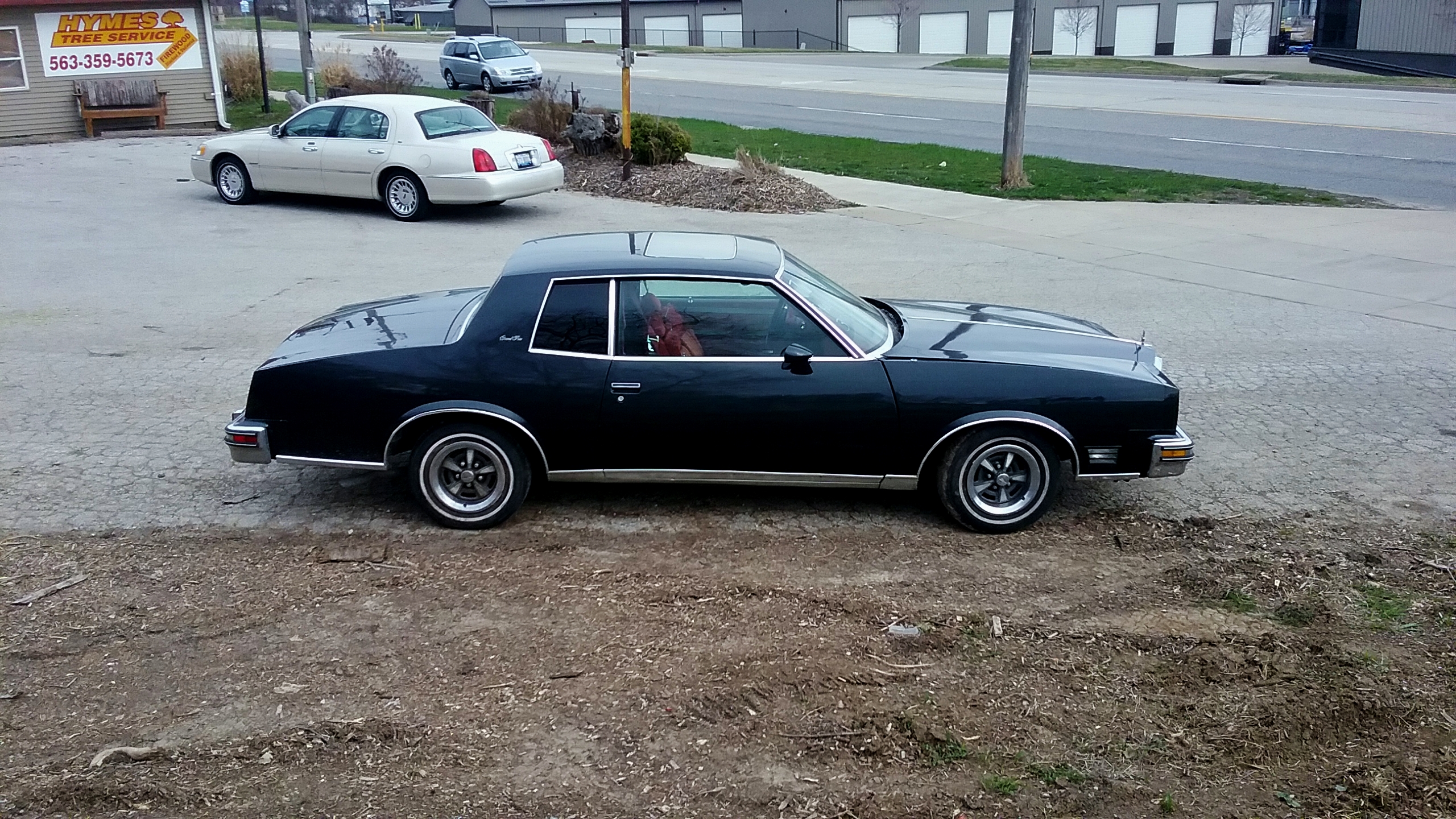
In 1978, the Pontiac Grand Prix was downsized, along with its corporate cousins, the Oldsmobile Cutlass Supreme and the Chevrolet Monte Carlo. And the Buick Regal, of course, which I covered previously here at RG.
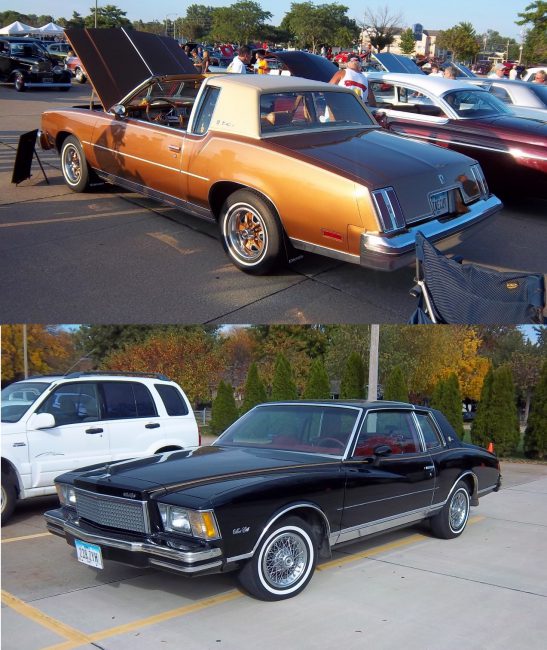
Phase II of General Motors’ downsizing had begun. The Colonnade midsizers of 1973-77 were but a memory, and Bill Mitchell’s Sheer Look, pioneered by the 1976 Cadillac Seville, was applied to all A-bodies, including the A-special GP and Monte.
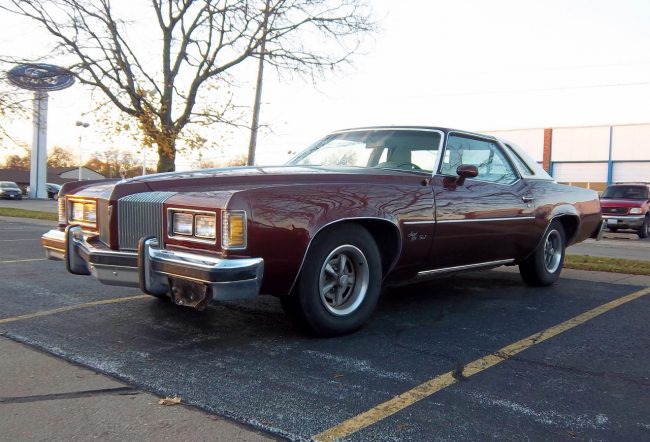
It was probably a surprise to showroom visitors. The previous Grand Prix was bold and flashy. Long hood, long doors, swoopy lines and options aplenty! But when the B-body full-size Bonnevilles and Catalinas were trimmed down in 1977, the Colonnade Grand Prix, Grand LeMans and LeMans were uncomfortably close to their bigger brethren, dimensionally.
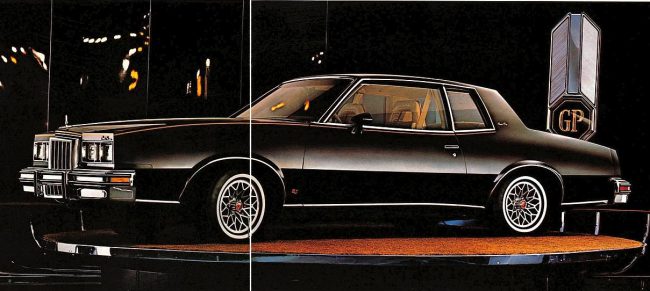
But that was corrected for model year ’78. Everything was new. But while the trim levels and myriad options continued, the Grand Prix definitely had a new look.
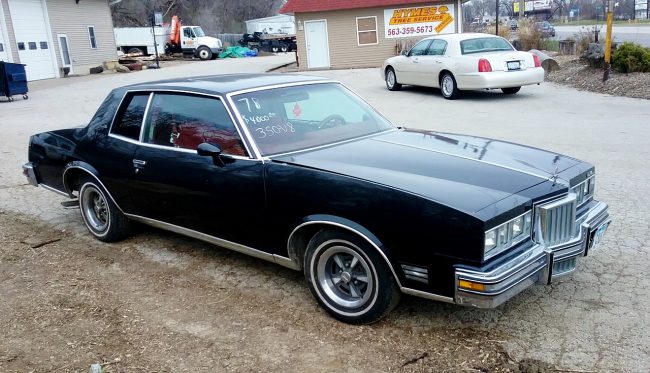
Of course, the biggest difference was the trimmed-down size. But the sheer look replaced the swoops and curves of the 73-77 GP with a severe squared-off look.
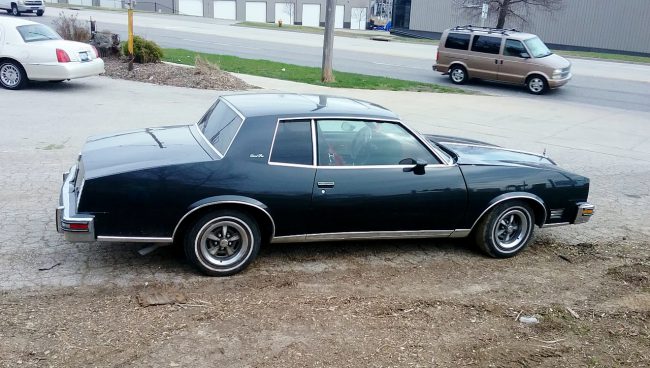
For 1978, it was right up to date. Fresh and new, and sharing its modern look with the reduced-fat Bonneville Broughams, Bonnevilles, Catalinas and Safari wagons it shared showrooms with. It looked especially good in dark colors and a slick top, as our featured car shows.
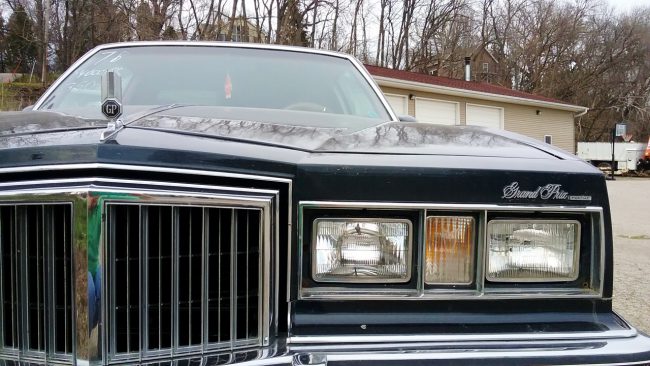
However, many of the traditional Grand Prix styling cues were retained, albeit in smaller packaging. Neoclassical grille? Check. Long doors? Check. Broughamy options such as landau roofs with opera windows, crushed velour interiors, and wire wheel covers? Double check!
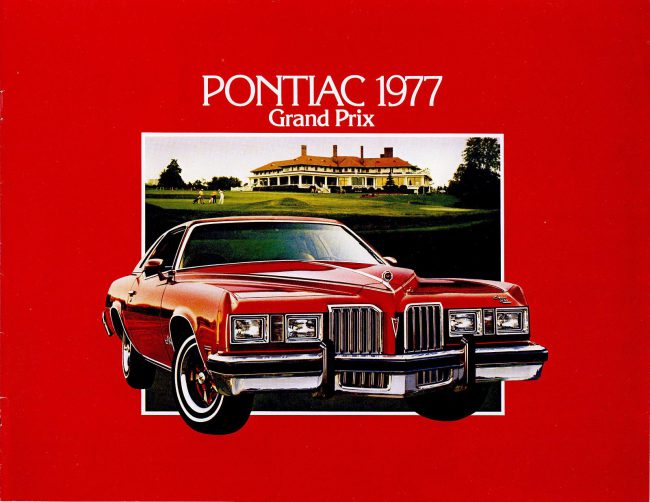
The quad rectangular headlamps with parking/turn signal in between aped the ’77, though the body color section between grille nostrils was jettisoned in favor of a more formal version.
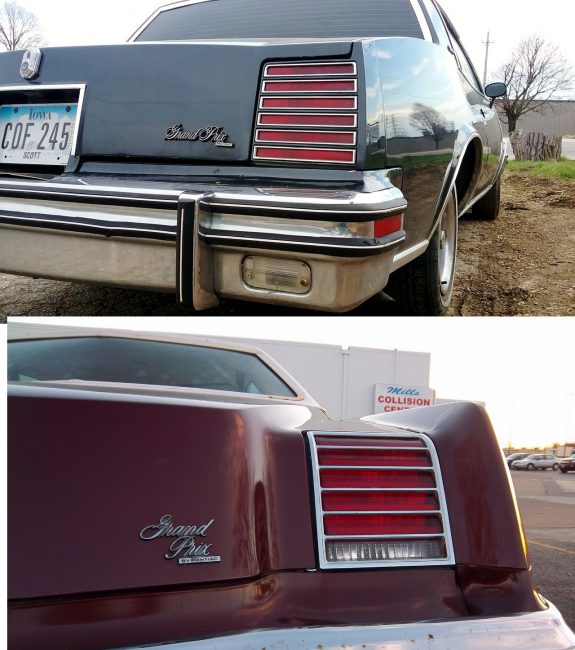
Out back, the horizontal taillamps recalled the 1976 Grand Prix. And of course, the cursive badging and “GP” crests were retained.
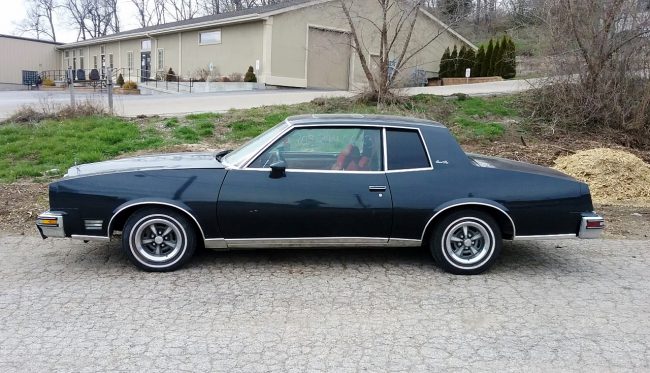
Of course, the usual prose was well in evidence in the showroom brochure: “This year, a dramatically new car has earned the right to bear the Grand Prix name. To symbolize Pontiac’s dedication to styling flair and performance. To engineering innovation and luxury that never gets in the way of driving.”
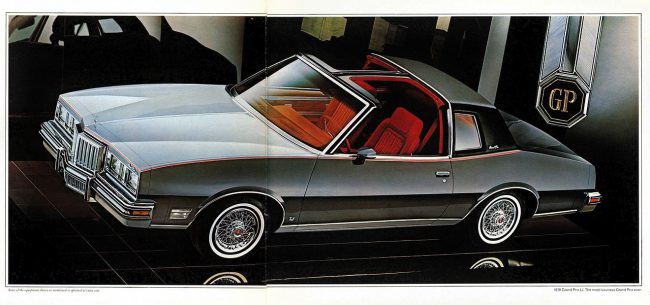
“One look reveals this car’s heritage. The clean lines. The crisp flanks. The chiseled look of the new radiator-style grille. The tailored look of the new roofline. The styling has a strength that’s unmistakably Grand Prix.”
The usual model lineup continued, with base Grand Prix, sporty SJ and luxury SJ models. A standard GP base priced at $4,880, with a 105-bhp, 3.8 liter V6 under the hood. That zero-option GP would also have had a three-speed manual transmission, believe it or not. But the higher-end SJ and LJ came standard with an automatic.
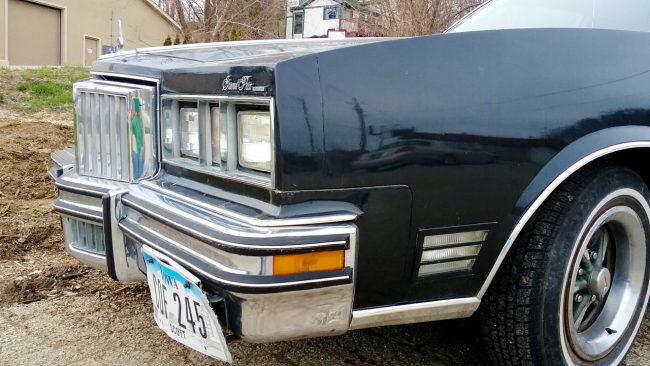
I initially mistook our featured car for an LJ, as it was pretty well equipped. It even had the optional cornering lamps.
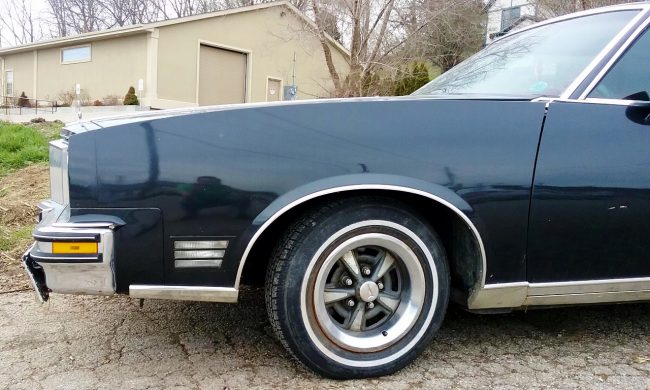
But wait! There’s no LJ badging on the front fender, as seen in the two tone car in the brochure picture further up! Of course, it could have been repainted at some point and said badges lost in the process, but this seemed to be a very original car, with only a recent-style aftermarket radio being other than factory spec.

The most unusual option on this car was the Astroroof. In the late ’70s the power Astroroof, GM’s term for a power glass moonroof, was not common on GM cars, though it was offered on many models, from Caprice Classics to Bonnevilles and Fleetwood Broughams. However, they were not cheap. Even on Cadillacs, they weren’t terribly common.
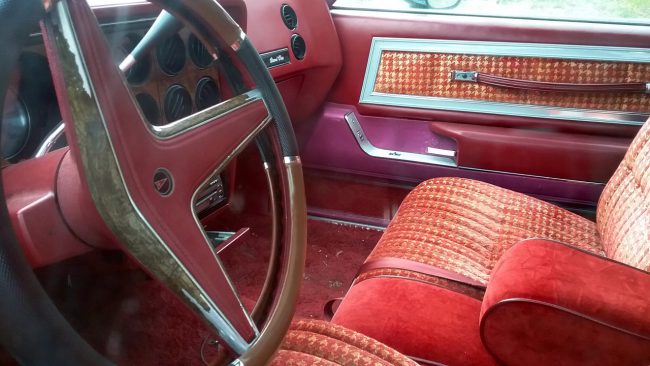
The red crushed velour interior with floating-pillow cushions was the uptown option as well. Bone stock base GPs had a pretty plain bench seat that would not have looked out of place on a Malibu station wagon. So this may actually be an LJ. It has the optional 60/40 front seat too.

But wait! The dash pad doesn’t have the fake stitching embossed into it!
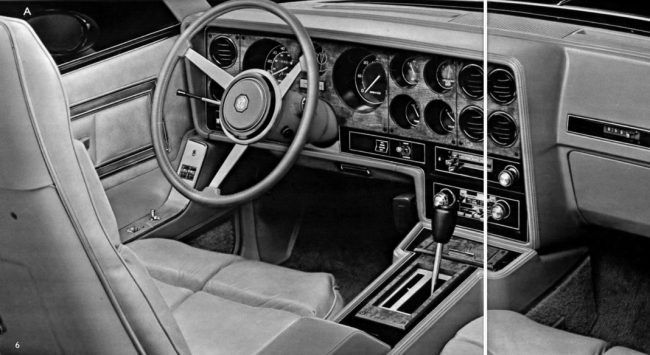
As you can see from this brochure picture, the stitching was pretty visible, and was standard on both the LJ and the SJ, making our subject Grand Prix a standard one.
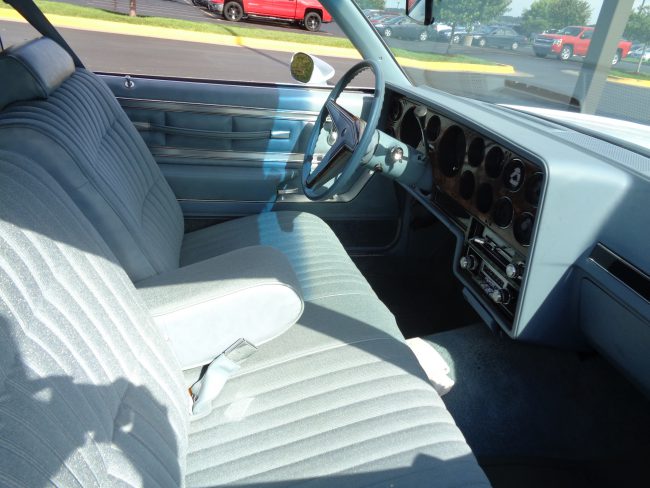
This picture of a ’79 spotted at the POCI meet in Bettendorf in 2016 shows what the standard seats looked like. Not bad, but not as Broughamy as floating-pillow backrests in red crushed velour!
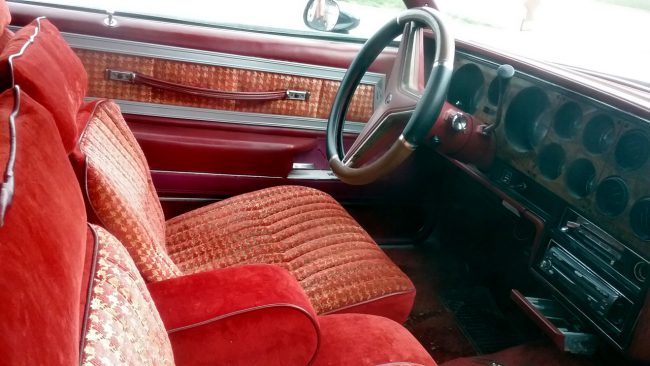
Back then, you could still order whatever options on whatever trim level you wanted, with only a few exceptions. So until proven wrong (I do have a message in to Carmine for confirmation) I am going to call this an uncommonly loaded base Grand Prix! UPDATE: Carmine concurs. As he related: “Odd car, it even has the “custom aire” wanna be pseudo climate control which has temp gradients on the a/c instead of hot-cold.”
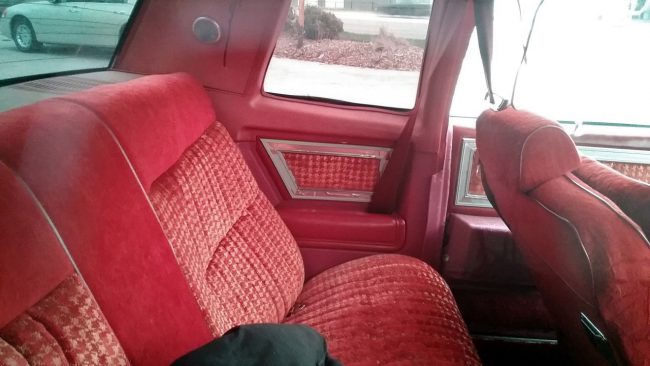
One interesting thing about the ’78s, the rear seat actually had more rear legroom than the 1973-77 Colonnade GPs. The recessed armrest in back to add elbow room was a cool touch too.
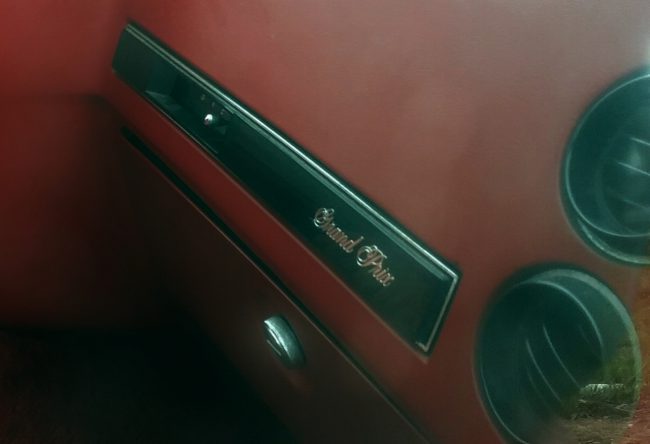
This car had the optional digital clock as well. One of the things I like about this vintage of Grand Prix are the “eyeball” A/C sockets. No mere up-and-down or left-and-right motion. Point them wherever you want!
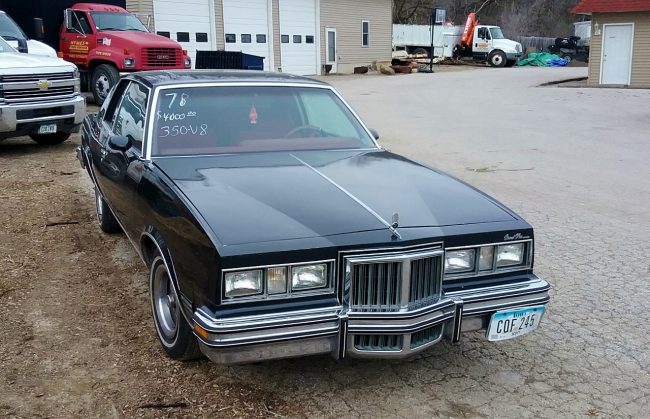
So then, this pretty much HAD to have been an ordered car. No Pontiac dealer would have ordered a base GP, then added so many options, when they could have ordered an LJ or SJ and had most of those things included before extras were added. Nope, someone really wanted a base car, but loaded.
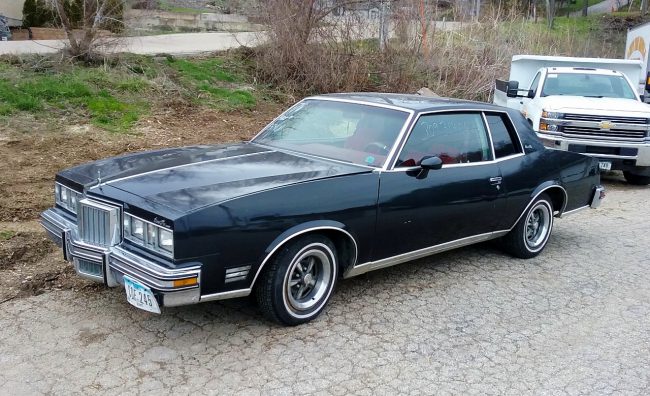
I spotted this particular example in April of this year. I had previously seen it a couple of years earlier, and have some pictures from that time as well, but at that time it had some goofy aftermarket chrome wheels on it. I knew it was a rare car, and figured I would write it up eventually, but those wheels kind of held me back.

So I was quite pleased when I drove by and saw it sporting period-correct whitewall tires and Rally II styled steel wheels. With those shoes, the slick top and in black over red, it was quite sharp!
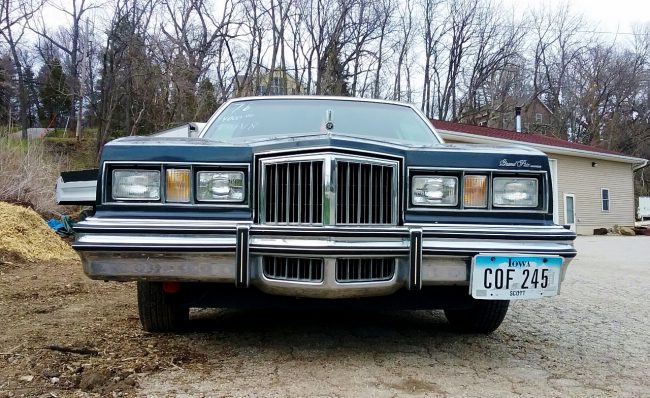
The ask was $4K, and claimed that it had a “350 V8”. But if true, someone added it years later, as the available V8s for the 1978 Grand Prix were limited to a 4.9L 301 V8 and a 5.0L 301 V8. Odds are that this example has one of those, and it’s a case of mistaken identity. For some folks, everything is a 350 V8, haha.
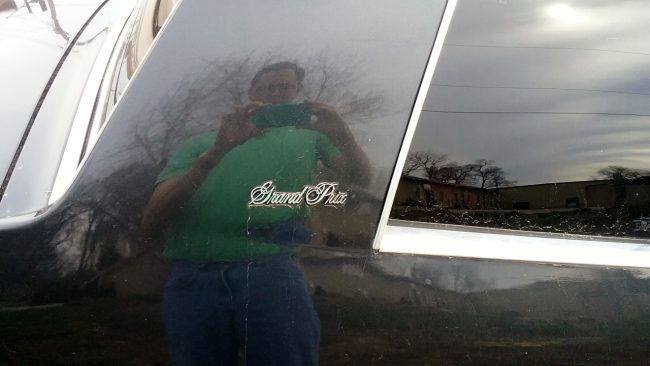
The usual suspects love to hate on General Motors, and some love to cite the ’78 A-bodies as a turrible, turrible thing. Ooh, bad GM! Bad bad bad! But those people tend to be the grudge-holding, flaky type, who revel in taking things out of context decades after the fact.
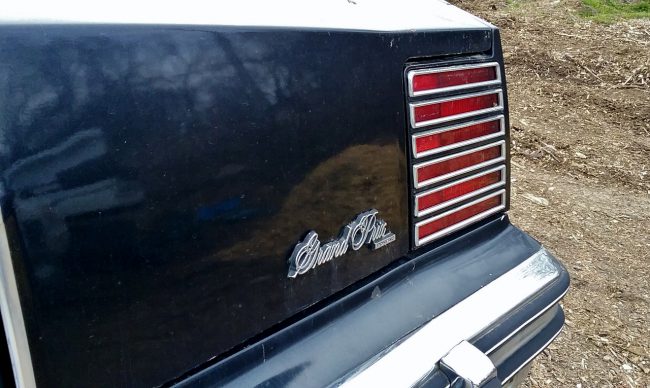
How so? Let’s see. How do I put this? Well, there are sites out there, one in particular, that has a serious bug up his posterior about motor cars made by General Motors Corporation. Why? Maybe he wasn’t hugged enough as a kid. Maybe a Seville ran over his foot one time. Maybe he’s just an angry, negative person. But at any rate, this unnamed site likes to tell you how stupid GM is. They joyfully beat this dead horse over and over and over. And over. And over again. Gets old? Yep, you bet! But they do it over again and again! To the point that sometimes said bilious posts will get re-run. Or perhaps a “new” post that is a thinly veiled variant of an earlier post.
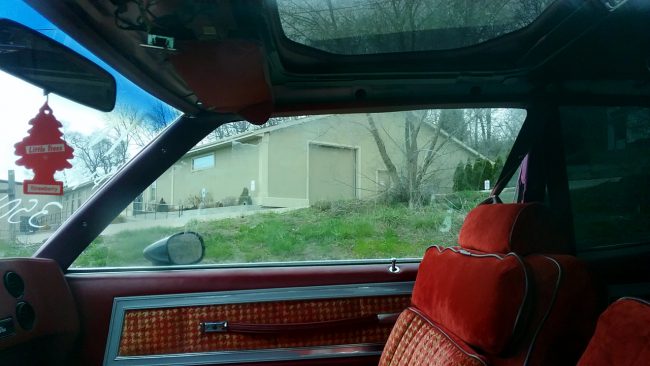
That is, when they aren’t ripping off three-year-old articles from Auto Week or swiping Road & Track articles and “publishing” them from their stash of thrift store issues from the 1970s. But, as is oft times the case, I am digressing.
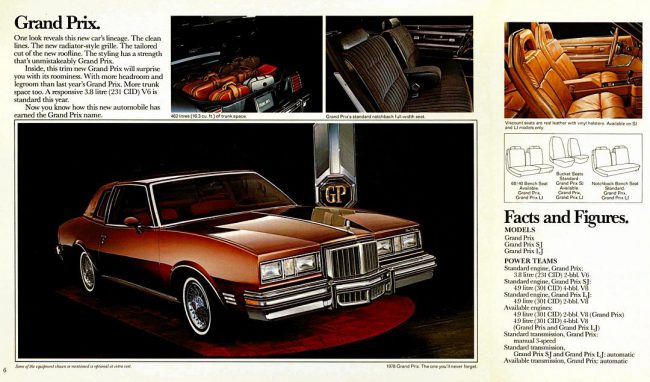
The point is these cars, contrary to those who wish otherwise, were not sales dogs. The 1978 Grand Prix sold quite well, with 127,253 base models, 65,122 LJs and 36,069 SJs built for the year. While that was down 60,000 units from 1977, that is most likely due to knowledge of the ’78 downsizing and those wanting more Brougham for their buck rushing down to get a final Colonnade ’77.
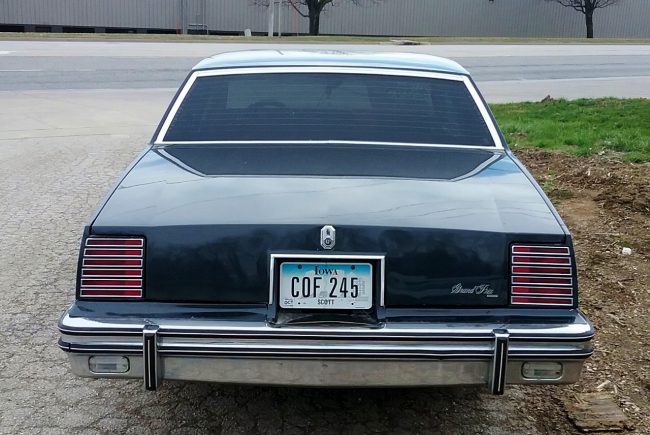
“Ooh! Ooh! The 78 was a bomb because they sold 60K less than ’77! Baaaad GM hurr durr durr!” some folks might digitally state. But take a look into production numbers and you’ll see that was about the same as 1976 Grand Prix production, which was 228,091. And ’75 GP sales were only 86,582. True, 1975 was a recession year, but still.
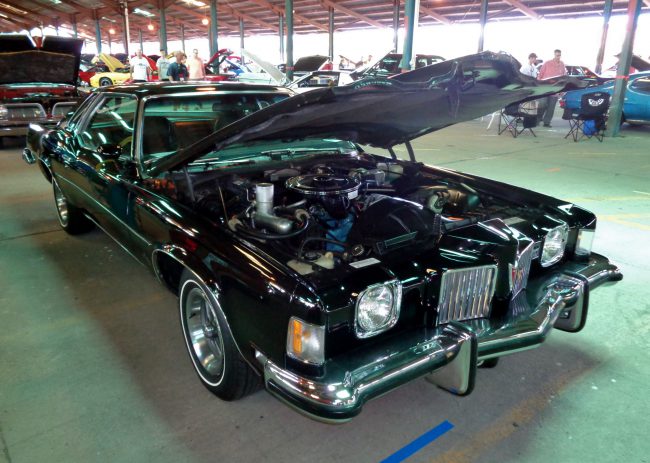
Heck, even in the first year of Colonnade GP production, sales were 153,899. And ’73 was a banner year for U.S. car production.
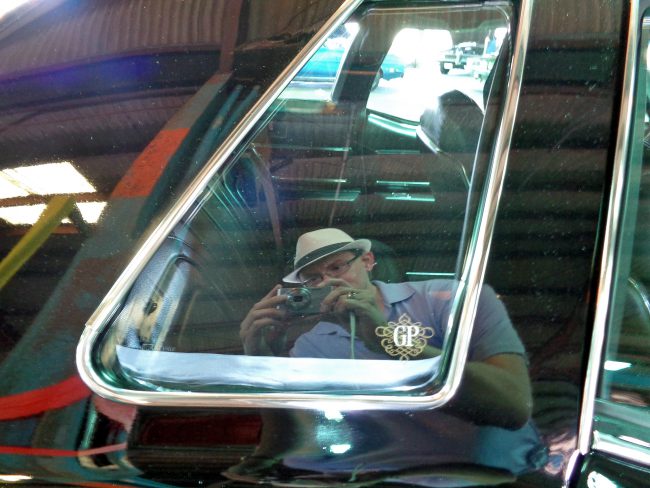
But golly, that wouldn’t fit in with the anti-GM brigade. So they think what they think and type what they type, and continue their delusions. Hey, I know GM made mistakes. Heck, in the ’70s pretty much all auto manufacturers were tripping up over the new safety and emissions requirements that were being initiated over and over, seemingly every week.
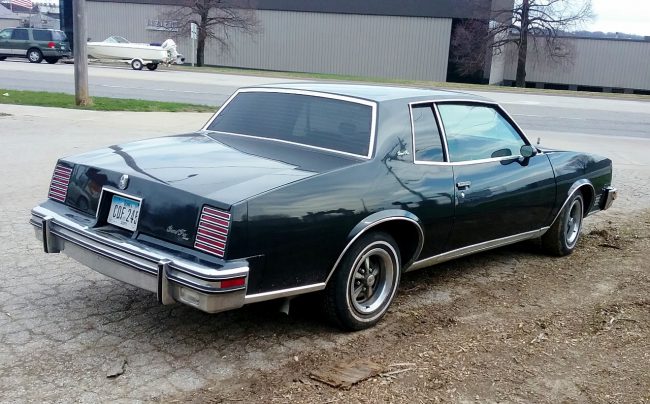
My point is all manufacturers screw up. And have. And will. I try to accentuate the positive. When I was a kid a friend’s dad had one of these, a ’78 in Dresden Blue with a white landau top and crushed blue velour interior. Sport mirrors and the always nice Snowflake alloy wheels. And plenty of folks bought these in 1978-80. Were they perfect? No. But what was in the 1970s? Indeed, the 1978 A-body platform lasted all the way to 1987 on the Grand Prix, albeit with a somewhat extensive restyle in 1981. The GP’s siblings the Monte Carlo and Cutlass Supreme coupe sold even better, and those too lasted an extra year, to 1988, before finally being superseded by the W-body front-wheel drive GM coupes. Hardly fodder for a hit piece.
The point? Like what you like, and drive what you love. They remind me of my childhood, of cars seen on my parents’ street and downtown, and at the grocery store. They have a style of their own. Though they weren’t as flashy as the Colonnade GP, they still look good today.
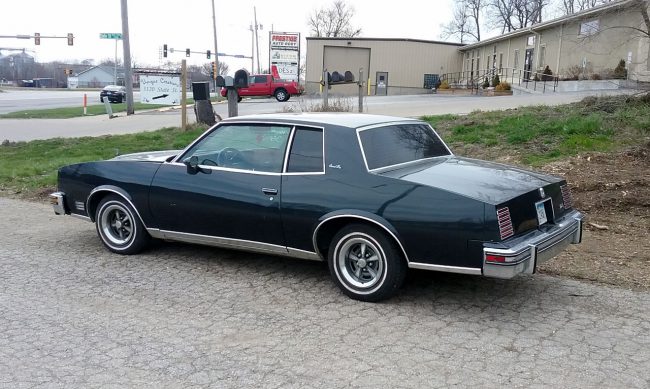








27 Comments
Love these long hood & short back G-body cruisers. My first car purchased in 1991 was a 1978 Buick Regal. 305 V8, two tone green with pint stripe and green vinyl roof. Plush padded velour green interior and wire wheels. Oddly enough, totally beautiful! And enough torque for a little fun. Went to a Pontiac 6000 LE after that and regretted the “upgrade”. Thanks for the trip down memory lane.
A body vs G body? Hmmmn…always though it was G. Differences?
It wasn’t G-body until the FWD A-body arrived in 1982. That A-body was fundamentally a LWB X-body.
That’s the way I remember it at the time. Everybody always talked about A-body through the Seventies. It made sense… A-body intermediate, B-body full-size, C-body prestige.
The FWD A’s were meant to replace the bulk of the RWD A body cars, the LeManes, Malibus, Cutlass and Century became the 6000, Celebrity, Ciera and…..Century.
It was only because the personal luxury versions like the Supreme, Monte Carlo, Regal coupe and GP were still popular that they got the G-body designation and continued to live, if they would have been slow sellers, they would have died with the rest of the RWD A cars in 1981.
G originally was used for the “long front” slightly stretched A-body that was used for the 1969 Grand Prix and 1970 Monte Carlo.
PN would have hated this one. He had a 78 as a deadly sin because the interior was too plain. Well not this one. A weird critique since he would normally describe the added luxury as fluff, The idea that it started pretty basic but could be customized to fit an individual is anathema to foreign car buyers. They thought at the time that buying foreign was in itself an expression of individuality. Not so much now of course and look what was lost.
I think leasing had more to do with killing off oddball option combinations. Every car is equipped the same right down to the paint color now so that it will have as much residual value as possible and roll off the lot as cheaply as possible.
Not sure about that, remember the early days of Honda when they could part every combination including option and color in one field. There position seemed to be that it showed how efficient, smart and of one purpose they were. Not just that only one way could be built to discourage special ordering with the impossible overseas wait times.
Once Honda moved much of their production to Ohio and Ontario, there was little reason to keep making cars only two ways in three colors. The reason they kept doing it was because they discovered that it contributed to resale value to not have a bunch of ridiculous cars tailored to inDUHvididuals. It is also much cheaper to give everyone every substantive feature rather than having infinite combinations of intentionally punitively bad and frivolously silly configurations.
Yea I suppose inDUHviduals really suck. They might want something silly like a sport package or an engine with enough torque for the automatic. We can’t have that, our engineers would have to learn or steal something new.
I had a 78 LJ. Everything wss included except a T top. It had wire wheel covers, buckets, console, velour type seats, and a/c. LJ initials on both sides. Mine was 2 tone blue, with gold pin stripes. 301. And a landau top. Really nice for the new body style.
I sold it to my parents in 84. They traded it in in 87 for more than they paid for it. We had 4 Pontiacs in our family back then !
I would say this was the last full-line of redesigned GM cars that was very successful in execution. They sold very well by capturing the “personal luxury” styling that was popular at the time while being significantly smaller and more fuel efficient, and these cars were generally well built and reliable by the standards of the time. GM even offered some significant innovation and differences between division offerings by offering turbo-charging on the Regal, fastback styling on Olds and Buick 4 and 2 door sedan variants (which proved unpopular), and fixed rear door glass to carve out a bit more rear elbow room (and cut costs). The biggest weakness of these cars is they probably should have been unit body to cut weight, as the comparable Ford Fox body Fairmont was considerably lighter and could therefore further boost Ford’s CAFE by offering tolerable 4 cylinder variants. If GM had done as good a job on the X-bodies, A-bodies, 86 E-Bodies, N-Bodies, GM10s, etc. as they did on the 1977 and 78 downsizings, they would likely still have 35% of the US market.
I read a period review of a 1973 Chevrolet Laguna S3 the other day. The writer was floored by GM producing Colonnade coupes that punished their scales to the tune of 4,600 lbs. Only a few years earlier, full sized Chevrolets weighed significantly less and loaded Chevelle SS396s were 3,800 lbs. The Laguna could barely get out of its own way with a 4 barrel carburetor on its 454 cubic inch engine sucking down a gallon of gas every 7.5 to 12 miles. I wonder what this generation intermediate would have been like without fuel crunch and CAFE?
Might be a little off or had much equipment plus the Laguna S3 was a 74. I found the 73 Chevelle SS454 colonnade with the four speed had a curb weight of 3937 and did 0-60 in 7.2, so not so bad and swiveling buckets! The options were so wide then that the basic 73 Chevelle 2 door 4.1 inline six was a trim 3538 pounds.
Yeah, and a new Toyota Fatlander, whoops, I mean Highlander, is 4100-4600 lbs. But that’s like, totally different, man! 🙂 Most current midsize sedans are still in the 3500-lb. range though.
Car and Driver tested and weighed it. If they say the 1969 SS396 they tested weighed 3,800 lbs and the Laguna S3 they tested in 1973 weighed 4,600 lbs, I’m more inclined to believe them than an automaker’s catalog. That goes for any automaker, and isn’t meant as a slight against GM. Claimed curb weights don’t mean much. The quarter mile was pushing 17 seconds and the back seat was no bigger than a Cosworth Vega’s in some dimensions.
The Toyota Highlander is an amazing combination of capabilities and quality. The 3rd row seat of a Highlander is more commodious than the back seat of a Colonnade PLC. Don’t even ask about 0-60 or fuel economy.
Wonder if C/D had Chubby Checker and the Fat Boys doing the Twist in the back seat? That would help slow it down and then they wouldn’t have had to work so hard to come up with reasons not to like it. I mean a 454 with a four speed, sucking lots of gas through a 4 barrell, who wants that, only Bubbas that we hate.
I have the magazine in front of me now. It’s the February ’74 Car and Driver. The Laguna S3 had a curb weight of 4,610 lbs and went from 0-60 in 7.8 seconds with its 235 hp 7.5 to 13 MPG 454 engine. The front seat had lots of space and comfort even without reclining seats, but the back seat made the Laguna a 206.3 inch long 2+2.
In my copy of Standard Catalog of American Cars 1946-75, shipping weight of the S-3 is not listed, but a ’74 Monte Carlo Landau was 3,950 and a 9-passenger Malibu Classic Estate Wagon 4,338. The difference could possibly be the 454 V8 and a full tank of gas. Interesting.
I checked C/D’s website to see if they had the S3 review uploaded to their archive. They didn’t, but they did have a test of a 1970 Chevelle LS6.
Reasonably well-equipped for the time (power steering, automatic, AM/FM, rear speaker, seat belts, bucket seats, center console, clock, upgraded steering wheel, vanity mirrors) its as-test price was $4470, or about $29K in today’s money.
Anyway, it ran a 5.4 second 0-60, 13.0 second 0-100, and 13.8@103 quarter mile. On 220mm polyester tires and 3 speeds.
I don’t know how people that had access to the performance cars of the late 60s survived the cliff-dive that came soon after.
CAFE didn’t really go into effect until 1978 from what I recall, with full compliance and gs guzzler taxes not going into effect until 1985, what really strangled these was the lo-lead no-lead “de-compression” and the addition of stuff like the EGR and the catalytic, plus the 150lbs of bumper on each end of the car.
I’d have to really see some data about a 1973 Laguna with a 454 “not being able to get out of its own way” in 1973 a 454 was still about (of the top of my head) 230hp and at least 320plus lb-ft of torque car,so its not exactly a diesel Rabbit…….. so unless you have some numbers that seem slow even for 1973, I’m gonna have to call bs.
CAFE had no influence on the Laguna S3. It was an indication of where GM was headed without oversight. CAFE did guide the creation of the 1978 Grand Prix. I was just wondering what it would have been had gasoline supplies remained unfettered and the government remained within the bounds of the constitution.
Ah, memories. I owned a ’79 SJ in the late 80’s, silver with the red crushed velour interior shown above and T-tops, and the 301 V8. I bought it from my sister and it already had a few miles on it at that point. The silver paint was a little faded but I had a lot of fun in that car, even though my friends teased me about the French cat-house interior.
Yes, memories. It’s impossible to separate cars of various periods, with our own memories of the times. 1978 was to me a sort of Peak Youth – it was chaotic, but filled with hope for the future. I lived in a picturesque resort area; and I so-well remember the summer and fall of 1978…in a leafy, neo-Victorian village filled with maples and birches, turning the dramatic shades that they do in a Great Lakes fall. I was young, I had, I thought, potential; the weather was bracing, the surroundings beautiful…in the background there was a Toni Tennile lookalike that I thought I had a chance with.
And GM brought out these cars, to follow up on the downsized B bodies. Even the cars were getting better-looking. Once I had my degree, and could set up my law office…I’d be able to live like the successful people around me…
Today, I remember all that and just shake my head. But those cars remain as beautiful as ever…my distaste for GM notwithstanding.
Always loved these, one cool thing about these GP was they got these cool unique lower door panels that swept into the dash, none of the other GM intermediates got that, plus these had a great dash, true that if you didn’t opt for the gauges, all those racy circles were filled with warning lights, but you could opt of for a pretty comprehensive gauge cluster with a big tach right next to the speedo.
These had a great console when you ordered the bucket seat option too.fitting nicely right under the bottom of the dash. Make mine a black t-top SJ with the snowflakes like the one up in the article, loaded up with the 4bbl 301.
Love the look of the 78s, despite the downsizing, but loved when they made it even more aerodynamic in 81. Still have one.
I’ll take mine in the two-tone black and grey, with T-Tops and red interior, and with the snowflake wheels please.
That’s a particularly nice find, ever with the weird option package. But, back in the day, folks were just as likely to order a car rather than pay for one off the lot. My brother did a similar thing back then, he wanted his new car e x a c t l y his way and was willing to wait for it. I think many of us buy cars now “off the rack”, much like our suits.
As nice as this is and as much of a Pontiac fan as I am, I think I’d still go with the Cutlass, either then or now. Now, I have nostalgic feelings for the Olds, but if offered, I wouldn’t kick the Tin Indian out.